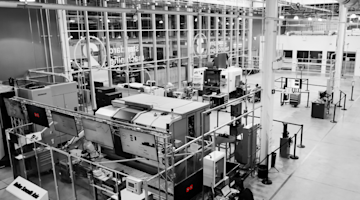Elsewhere in this edition of AMT News, there are summaries and articles on my outlook presented to IMTS exhibitors, Alan Beaulieu’s outlook presented at EASTEC, and Bill Strauss’s update presented to the MTForecast community. It really doesn’t make sense to give a fourth dose of the same news. The U.S. manufacturing landscape continues to grow, albeit at a slower pace. This development, in conjunction with concerns about trade policy impacts on exports, points to a decline in manufacturing technology orders in 2019 over 2018.
Oxford Economics and the Institute for Trend Research seem to have similar outlooks for our industry’s market over the next two years. The current expansion will continue into the second quarter. Negative year-on-year change in the growth rate will likely begin in the late second quarter or early third quarter. The last downturn lasted for more than 40 months, but the expectations are that this next downturn will likely be a quarter to a third of the length of the past one. It does mean that the last half of 2019 and most of 2020 will see continued contraction in markets. However, both organizations suggest that the market has a good chance to be in an upswing before the end of 2020.
As always, the negative scenario could accelerate, if , for example, our trade issues with major trading partners become dourer. Likewise, if Congress were to pass a major infrastructure bill, the downturn could stall or reverse its course for a year or more. But the odds are greater that the contractions will start sooner rather than later.
It is easy to see why the analysts continue to remain optimistic. The top 10 indicators for our industry still look healthy. Most suggest continued growth or no weakness, while a handful provide cause for caution. As noted last month, Gardner’s Metalworking Business Index is below 50, signaling an impending contraction in manufacturing technology. The index led the last expansion by about four to five months – again pointing toward a June/July time frame for the start of a downturn. Complementing the MBI, the Purchasing Managers’ Index — while still signaling expansion — has fallen closer to the expansion/contraction line of 50. The timing on the PMI has typically been 90 days, but that clock hasn’t started ticking yet.
Two indicators point to a longer run on the expansion – Capacity Utilization and Durable Goods’ Orders. Durable Goods’ Orders peaked in August and September but have made up most of the loss in the past two months. Orders are significantly higher than the 12-month average prior to August but have not yet topped the peak levels set in August and September. While the capacity utilization rate dipped early in 2019, the current level and the flow of technology to the production floors suggest greater activity than an excellent 76 percent in February suggests.
Finally, the timing on the U.S. downturn in manufacturing investment will be at the tailend of the global trend in declining investment in manufacturing. German manufacturing investment levels began to slow in the first quarter of 2018 and are forecasted to begin picking up speed in the third quarter of this year. Korea’s manufacturing investment trend went negative in the second quarter of 2018 and will push into positive rates in the second quarter of 2019. The point is that the U.S. expansion has outlasted the expansion of other nations’ manufacturing technology. The positive side of that point is overseas markets should become healthier and expand sooner than the U.S. market. This scenario would ease the strain on our domestic market to support foreign manufacturers.
The U.S. manufacturing technology industry is in for tougher times. Still, the analysts are looking for nothing greater than a 10-20 percent decline from the peak in 2018. I think almost anyone would agree that a bottom of the downturn that is no more than 20 percent off 2018 levels would be sustainable, maybe even profitable. The concern here is that exogenous forces (trade issues, confidence in the dollar, etc.) caused by politicians or hair-triggered traders could spike that 20 percent figure further download.







